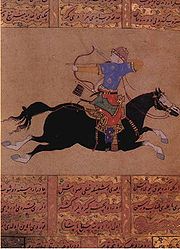
Turkish bow
Encyclopedia
The Turkish bow is a recurved
composite
bow
used in the Ottoman Empire
.
 The construction was that of the classic Asiatic composite bow
The construction was that of the classic Asiatic composite bow
, with a wooden core (maple was most desirable), animal horn on the side facing the archer, and sinew on the back. Animal glue
held it together. From the decline of military archery, mainly flight archery was practiced, and the standard Turkish bow became a particularly light and efficient weapon. The sport declined gradually until the reign of Mahmud II
who made great efforts to revive it. He also ordered his archery student, Mustafa Kani, to write a book about the history, construction, and use of these bows, from which comes most of what is now known of Turkish bowyery.
After the death of Mahmud II in 1839, archery declined. The living art of Turkish bowyery was lost in the 1930s with the death of the last bowyer and famous calligrapher, Neçmeddin Okyay; it has since been revived. For many years their efficiency and excellency could be seen from historical records, where in the Ottoman Era the record distance for an arrow shot was 845.5m. (Bows made only of wood have been much less suited to flight archery; the northern European flight archery record to 1910 was 340m, achieved with a long-bow of Osage-orange
wood, and a force of over 700N or 157 lb was needed to draw the bow.) In 1910 an archery contest was held on the beach at Le Touquet, France, where Ingo Simon was able to shoot an arrow 434 m using an old Turkish composite bow requiring a force of 440N or 99 lb.
Recurve bow
In archery, the shape of the bow is usually taken to be the view from the side. It is the product of the complex relationship of material stresses, designed by a bowyer...
composite
Composite bow
A composite bow is a bow made from horn, wood, and sinew laminated together. The horn is on the belly, facing the archer, and sinew on the back of a wooden core. Sinew and horn will store more energy than wood for the same length of bow...
bow
Bow (weapon)
The bow and arrow is a projectile weapon system that predates recorded history and is common to most cultures.-Description:A bow is a flexible arc that shoots aerodynamic projectiles by means of elastic energy. Essentially, the bow is a form of spring powered by a string or cord...
used in the Ottoman Empire
Ottoman Empire
The Ottoman EmpireIt was usually referred to as the "Ottoman Empire", the "Turkish Empire", the "Ottoman Caliphate" or more commonly "Turkey" by its contemporaries...
.

Composite bow
A composite bow is a bow made from horn, wood, and sinew laminated together. The horn is on the belly, facing the archer, and sinew on the back of a wooden core. Sinew and horn will store more energy than wood for the same length of bow...
, with a wooden core (maple was most desirable), animal horn on the side facing the archer, and sinew on the back. Animal glue
Animal glue
An animal glue is an adhesive that is created by prolonged boiling of animal connective tissue.These protein colloid glues are formed through hydrolysis of the collagen from skins, bones, tendons, and other tissues, similar to gelatin. The word "collagen" itself derives from Greek κόλλα kolla, glue...
held it together. From the decline of military archery, mainly flight archery was practiced, and the standard Turkish bow became a particularly light and efficient weapon. The sport declined gradually until the reign of Mahmud II
Mahmud II
Mahmud II was the 30th Sultan of the Ottoman Empire from 1808 until his death in 1839. He was born in the Topkapi Palace, Istanbul, the son of Sultan Abdulhamid I...
who made great efforts to revive it. He also ordered his archery student, Mustafa Kani, to write a book about the history, construction, and use of these bows, from which comes most of what is now known of Turkish bowyery.
After the death of Mahmud II in 1839, archery declined. The living art of Turkish bowyery was lost in the 1930s with the death of the last bowyer and famous calligrapher, Neçmeddin Okyay; it has since been revived. For many years their efficiency and excellency could be seen from historical records, where in the Ottoman Era the record distance for an arrow shot was 845.5m. (Bows made only of wood have been much less suited to flight archery; the northern European flight archery record to 1910 was 340m, achieved with a long-bow of Osage-orange
Osage-orange
Maclura pomifera, commonly called Osage-orange, hedge-apple, Horse-apple, Bois D'Arc, or Bodark, is a small deciduous tree or large shrub, typically growing to tall. It is dioeceous, with male and female flowers on different plants...
wood, and a force of over 700N or 157 lb was needed to draw the bow.) In 1910 an archery contest was held on the beach at Le Touquet, France, where Ingo Simon was able to shoot an arrow 434 m using an old Turkish composite bow requiring a force of 440N or 99 lb.

